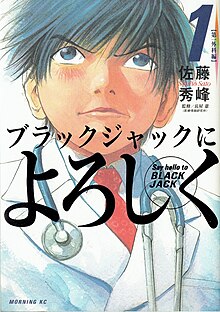This article needs additional citations for verification. (September 2014) |
Seinen manga (青年漫画) is an editorial category of Japanese comics marketed toward young adult men.[1] In Japanese, the word seinen means "youth", but the term "seinen manga" is also used to describe the target audience of magazines like Weekly Manga Times and Weekly Manga Goraku, which write on topics of interest to male university students and workingmen. Seinen manga is distinguished from shōnen manga, which is for young boys, and seijin-muke manga (成人向け漫画), which are intended for adult audiences and often contain explicit content. Some seinen manga like xxxHolic share similarities with shōnen manga. Seinen manga can focus on action, politics, science fiction, fantasy, relationships, sports, or comedy. The female equivalent to seinen manga is josei manga.

A common way to tell if a manga is seinen is by looking at whether furigana is used over the original kanji text: if there is furigana on all kanji, the title is generally aimed at a younger audience. The title of the magazine in which it was published is also an important indicator. Usually, Japanese manga magazines with the word "young" in the title (Weekly Young Jump, for instance) are seinen. There are also mixed shōnen/seinen magazines such as Gangan Powered and Comp Ace. Other popular seinen manga magazines include Weekly Young Magazine, Weekly Young Sunday, Big Comic Spirits, Business Jump, Ultra Jump, and Afternoon.
In 1959, two of the main shōnen manga titles appeared: Weekly Shōnen Magazine and Weekly Shōnen Sunday. Then, in 1967, the first magazine aimed at seinen appeared: Weekly Manga Action, which scored big hits with Lupin III, Lone Wolf and Cub, and later Crayon Shin-chan. The year 1972 saw the addition of Big Comic Original, which featured Tsuribaka Nisshi, a manga about two older men who enjoy fishing; the manga was made into a series of popular movies. In 1979, the publisher Shueisha, known for Weekly Shonen Jump for teen boys, entered the seinen market with Weekly Young Jump. Many Young Jump series have been adapted into anime or live-action TV programs, such as Elfen Lied, Gantz, Hen, Kirara, Liar Game, Oku-sama wa Joshi Kōsei,Dragon Ball.
Magazines
editA list of the top Japanese seinen manga magazines by circulation in the time-span from October 1, 2009 to September 30, 2010.[2]
| Title | Circulation |
|---|---|
| Weekly Young Magazine | 807,871 |
| Weekly Young Jump | 768,980 |
| Big Comic Original | 729,750 |
| Weekly Manga Goraku | 500,000 |
| Big Comic | 454,000 |
| Comic Kairakuten | 350,000 |
| Weekly Morning | 340,209 |
| Weekly Manga Sunday (defunct) | 300,000 |
| Business Jump (defunct) | 285,334 |
| Super Jump (defunct) | 277,500 |
| Big Comic Spirits | 260,024 |
| Comic Shitsurakuten | 250,000 |
| Young Champion | 250,000 |
| Comic Ran | 207,350 |
| Big Comic Superior | 204,125 |
| Manga Action | 200,000 |
| Young King | 200,000 |
See also
edit- Children's manga: intended for young children
- Shōnen manga: intended for boys
- Shōjo manga: intended for girls
- Josei manga: intended for adult women
- Gekiga: a type of manga that was popular among male workers in the 1960's and 70's
References
edit- ^ "Everything about the Seinen Genre". Jappleng.
- ^ Loo, Egan (January 17, 2011). "2010 Japanese Manga Magazine Circulation Numbers". Anime News Network. Retrieved July 30, 2014.
External links
edit- Japanese Magazine Publishers Association (in Japanese) (archived 2 April 2007)